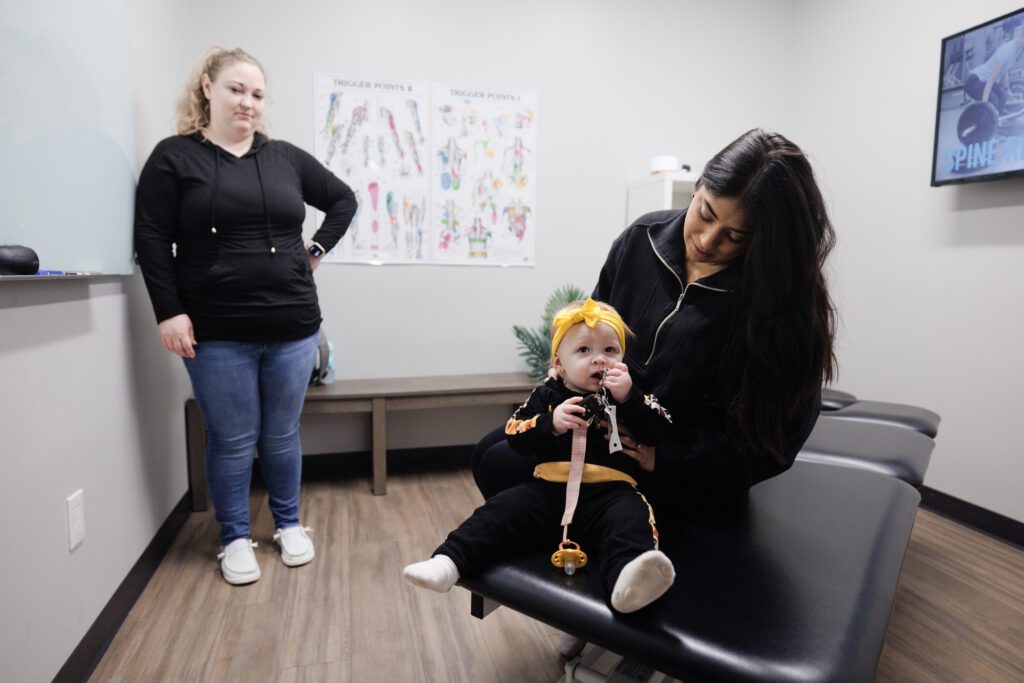Hi there! I’m Dr. Nisha Copeland—a licensed chiropractor with advanced training in pediatric care and a deep passion for helping kids thrive.
Over the years, I’ve had the privilege of working with families through every stage of childhood, from soothing colicky newborns to improving posture in growing teens. Parents often come to me with questions like: Is chiropractic care safe for my child? What does a visit look like? Can it really help with issues like colic, ear infections, or poor posture?
This guide is here to answer those questions—and to show you how safe, gentle chiropractic care can support your child’s health journey.

What Is Pediatric Chiropractic Care?
Pediatric chiropractic care is a natural, hands-on approach that supports your child’s development by improving the function of their spine, muscles, and nervous system.
Children’s bodies grow and change rapidly. From the moment they’re born, they begin a constant cycle of movement: rolling, crawling, walking, jumping, climbing. Along the way, things like birth trauma, falls, or postural habits can lead to tension or imbalances in the spine and nervous system.
That’s where chiropractic can help.
Unlike adult care, pediatric chiropractic is tailored specifically for growing bodies. We use gentle, low-force adjustments to help restore healthy motion and nervous system balance. This supports everything from digestion and sleep to focus, immunity, and more.
Common Reasons Parents Bring Their Children In:
- Colic or excessive crying
- Trouble with breastfeeding or latching
- Sleep disturbances
- Ear infections or congestion
- Postural issues (e.g., slouching, head tilting)
- Bedwetting
- Growing pains
- Headaches or tension
- Recovery after sports injuries or falls
- General wellness support
Is It Safe for Children?
Yes—chiropractic care for children is incredibly safe when performed by a trained pediatric chiropractor.
We use gentle, age-appropriate techniques that require only the lightest pressure—often no more than what you’d use to check the ripeness of a peach. There are no forceful movements or loud “pops” like you might see in adult chiropractic adjustments.
I’ve completed advanced pediatric training through the International Chiropractic Pediatric Association (ICPA) and continually stay updated on best practices in pediatric care. This ensures the care your child receives is not only effective—but also safe and appropriate for their age and stage of development.
What to Expect at a Pediatric Visit
We want your child’s visit to feel calm, welcoming, and fun.
When you arrive, you’ll be greeted in a kid-friendly space designed to make families feel comfortable. The first visit includes a full health history, a gentle hands-on exam, and a conversation about your goals and concerns.
We tailor our approach to each age group:
- Infants: Gentle cranial work, light spinal adjustments, and bodywork to address feeding, sleep, or comfort
- Toddlers: Play-based exams and low-force adjustments that are often done with the child sitting on a parent’s lap
- School-age kids and teens: Age-appropriate movement screens and more active engagement in the treatment process
Parents are encouraged to be present, ask questions, and be part of the care plan every step of the way.
Real-Life Examples from My Practice
Here are a few stories that highlight how pediatric chiropractic care can make a real difference:
1. Infant with Colic and Latching Issues
A 6-week-old baby came in crying through every feeding. Mom was exhausted, and latching was a struggle. We found tension in the baby’s neck, jaw, and cranial bones. After three gentle sessions, latching improved significantly, feeding became easier, and the baby (and mom!) finally got some rest.
2. Toddler with Frequent Ear Infections
A two-year-old had been on multiple rounds of antibiotics for recurring ear infections. Chiropractic care helped improve drainage by releasing tension around the upper neck and ears. Over time, the infections stopped recurring, and the child avoided surgery for tubes.
3. School-Age Child with Poor Posture and Headaches
A 9-year-old was experiencing daily headaches and slouched posture from extended screen time. Through regular adjustments and posture retraining exercises, the headaches diminished, and she gained confidence in how she carried herself.
Frequently Asked Questions
Does it hurt?
No. Pediatric adjustments are very gentle and often calming for the child. Many babies fall asleep during treatment!
How often does my child need to come?
It depends on the child’s condition and response to care. Some issues resolve quickly, while others—like posture or recurring infections—may need a series of visits.
Do I need a referral from my pediatrician?
No referral is necessary. That said, we’re always happy to work in collaboration with your child’s pediatrician or other healthcare providers.
What’s the youngest age a child can be adjusted?
Chiropractic care can begin shortly after birth. In fact, many parents bring their newborns in for a check-up after delivery to address any birth-related tension.
Choosing the Right Pediatric Chiropractor
When selecting a chiropractor for your child, make sure to look for:
- Advanced training in pediatric care
- Experience with children of all ages
- Membership in professional pediatric organizations (like the ICPA)
- A warm, welcoming environment where your child feels safe and supported
At our clinic, we check all those boxes—and more. Our mission is to help your child thrive through every stage of development.
Next Steps
If you’re curious whether chiropractic care could benefit your child, I invite you to schedule a complimentary consultation.
We’ll chat about your child’s health, answer your questions, and help you feel confident in the next step—whatever that may be.

Recent Comments